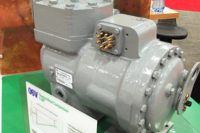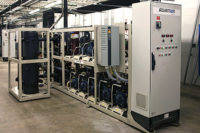CO2 as a refrigerant has been a part of the refrigeration landscape for close to a decade — from early efforts combining it with ammonia in cascade systems for industrial plants, to cascade and other approaches with HFC refrigerants in supermarkets.
The most anticipated next step was running CO2 as a standalone refrigerant in a system, which is being done in Europe in more and larger applications. Finally, the approach crossed the Atlantic and made a high profile debut less than a year ago in Brooklyn, New York.
This story takes a look at a few recent developments, beginning in Brooklyn.
Stateside
During a press briefing hosted by Danfoss at the AHR Expo in New York City earlier this year, Mike Ellinger, director of global maintenance and refrigeration for Whole Foods, talked about the transcritical CO2 store across the East River.
“Whole Foods Market is committed to reducing its environmental impact and supporting the health of its customers and team members, not only through the products it sells, but in how it designs, builds, and operates its stores,” he said. “We practice and advance environmental stewardship.”
He noted 11 existing Whole Foods stores with various types of CO2 systems including the 56,000 sq. ft. store in Brooklyn. He said that store uses a booster CO2 system with subcritical compressors on low temperature and transcritical on the medium temperature side. The Danfoss collaboration included VFDs, rack control, system control, case controls, pressure independent control valves, solenoid valves, and heat exchangers.
He said challenges included “higher initial system cost compared to a DX system, navigating permit requirements, lack of language in codes, and unexpected costs due to regulatory modifications.” This relates to an ongoing issue regarding CO2 as many of the technological advances are ahead of municipal code modifications.
Since the store has only been open a short period at the time of the presentation, Ellinger said, “We need six months-plus of analytic data to compare performance.” He also said Whole Foods will share a one-year report regarding the CO2 system performance.
At this point, he described one victory as bringing on-line “the first synthetic refrigerant free store in the USA, with zero ozone depletion and low global warming potential.” He noted refrigeration is contributing to “an expected whole building design energy savings greater than 60 percent above the ASHRAE 90.1-2007 baseline.” He added the store has earned GreenChill Platinum and LEED Platinum recognition, the highest levels in both programs.
United Kingdom
In a development a few months prior to the Brooklyn project coming together, the Sainsbury supermarket chain reported it was testing an Epta ECP2 small CO2 system in one of its stores in the United Kingdom. CO2 is used in all refrigerated cases in the convenience store. In addition the store was using 42 solar panels to generate electricity and double glazing for its LED lighting.
The innovations were part of what Sainsbury said was an effort to make the store “the greenest convenience store in the U.K.”
Italy
Carel is reporting on a transcritical CO2 store in Belluno, Italy. The refrigeration system uses CO2 for medium and low temperature in a direct expansion approach. An Epta control manages the system.
In the broadest sense, Carel explained the transcritical cycle this way: “In the cycle that is defined as transcritical, the normal condensation typical of chiller cycles using the most common refrigerants is replaced by a heat exchange between the refrigerant, which is at the higher pressure than the critical one and the cooling fluid. In transcritical operation, there is no phase change from gas to liquid but only the decreasing of the temperature of a gas that is gradually denser. The maximum operating pressure is no longer linked to the condensation temperature but is instead controlled by means of the assembly comprised of a valve and a liquid receiver.”
New Zealand
What was called New Zealand’s first transcritical CO2 refrigeration supermarket came on-line last fall in Auckland. The company Resource Data Management said it designed a monitoring system to optimize energy consumption to the mechanical system.
This was a retrofit project and was in response to new legislation in the country designed to encourage switching away from HFCs. The old system was pulled out and replaced by two CO2 packs. One was a booster system providing cooling to the low temperature side and some medium temperature equipment. The remainder of the medium temperature load is cooled by a second C02 pack. The system is linked to a heat recovery system which draws energy from both packs to heat the retail area and provide hot water.
Officials also said the store would be used for on-site training of technicians regarding working with CO2.
The Goods
In addition to the industry’s awareness of the need for more training when working with CO2, the need for products specific to that refrigerant are needed.
Drawing attention to that factor is Westermeyer Industries of Bluffs, Illinois. It issued a press release in late January announcing that it had expanded its product line to incorporate “a full line of code approved high-pressure components supporting operating pressures of transcritical CO2 systems.”
The product line includes oil separators, oil reservoirs, accumulators, and receivers.
“We are constantly striving to meet our customers’ needs and fulfill the needs of the refrigeration industry,” said company founder Gary Westermeyer. “Our transcritical products help our customers provide an environmentally friendly system to the end user, thereby meeting green initiatives.”











